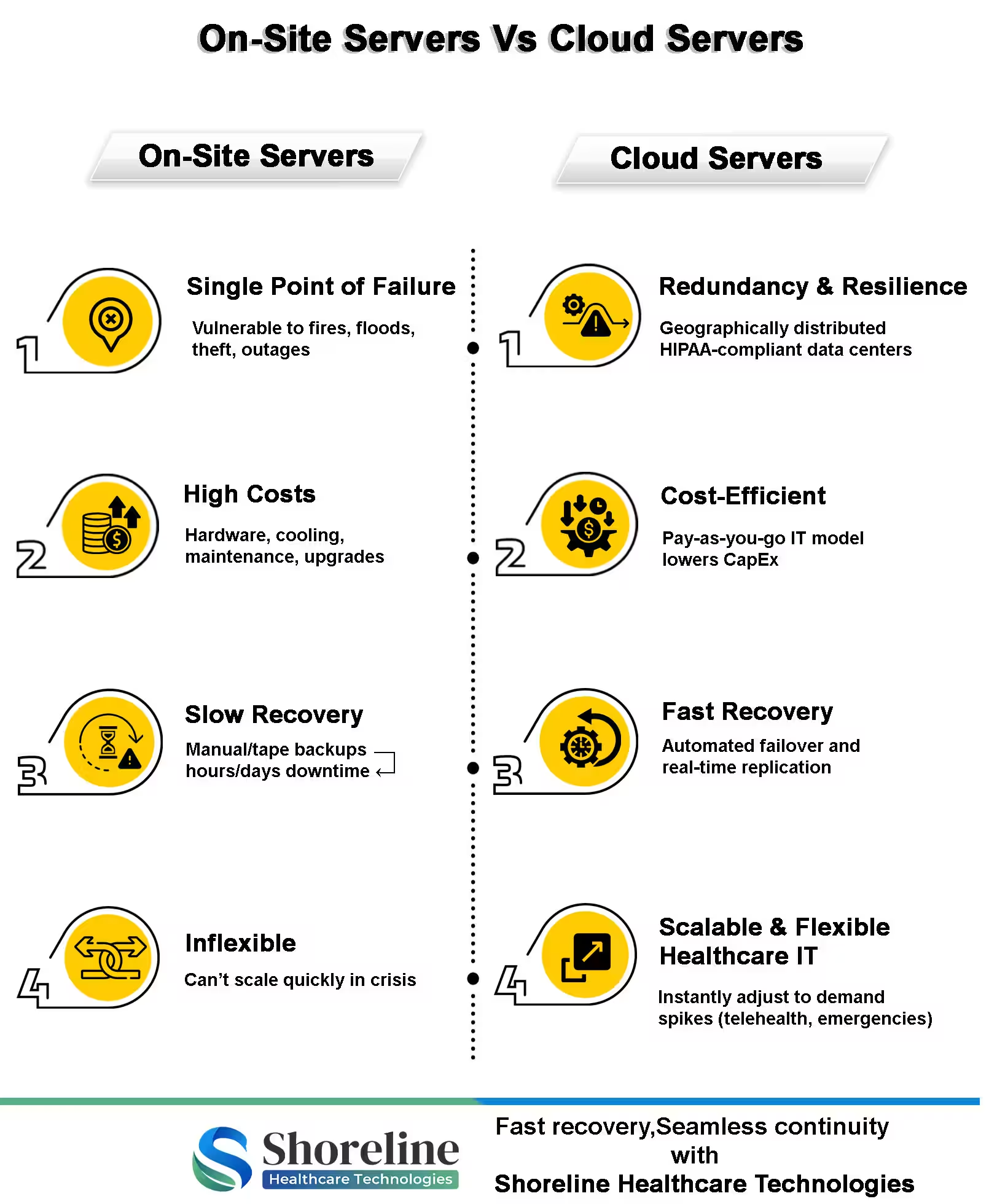Healthcare Cloud Infrastructure: Building Disaster Recovery and Continuity You Can Trust
The healthcare environment is highly vulnerable with unexpected disruptions from cyberattacks, natural disasters, and system failures that brings patient care and operations to a sudden halt. From patient care to billing systems, every second counts and unexpected disruptions can be costly. And healthcare operations cannot afford this downtime. This is where cloud computing comes in as a game changer. It can be a fundamental strategy for survival, growth, and delivering uninterrupted patient care. Its disaster recovery functions ensure your practice stays operational, even when crises strike. In this blog, we’ll learn how modern cloud solutions help in disaster recovery (DR) and business continuity (BC) to protect patient data, quickly restore systems after disruptions, and keep operations run smoothly. With HIPAA-compliant approach it cuts costs, increases security, and provide remote access, helping providers maintain high-quality care even during crises like cyberattacks or natural disasters.
Why is a strong disaster recovery plan essential in healthcare?
IT systems are the lifeline of patient care in health industry. And a failure in these systems can have severe consequences beyond just financial losses like delay in treatment, disrupts operations, and even put lives at risk. Hence a robust disaster recovery plan is essential in healthcare for managing the electronic health records (EHRs), scheduling appointment, checking lab results, billing the services and for using some medical devices. For instance, a downtime in patient records access could delay diagnoses, disrupt treatment plans, or even lead to life-threatening errors. Having disaster recovery plan is an ethical responsibility.
What do you mean by Disaster Recovery and Business Continuity?
Business Continuity is about keeping the healthcare facility operational even during a crisis. It answers the question, "How do we continue to see patients and manage operations when our primary systems are down?" It is the strategy for maintaining essential functions. Whereas Disaster Recovery is the ability to restore healthcare IT operations like restore patient data, applications, and other devices after a disaster has occurred. It answers the question, "How do we get our technology back online quickly and safely?"
Why Traditional IT Fails: The Limits of On-Premise Solutions

The traditional of on-premise server models are outdated with high level of risks.
- Single Point of Failure: The on-site servers are vulnerable to physical disasters like fires, floods, power outages, or even theft that puts everything to halt.
- Sky-High Costs: The capital expenditure for buying and maintaining the physical hardware is immense, with maintenance and upgradation costs escalating each time.
- Slow and Manual Recovery: The manual processing for backups is slow and are prone to human error. The restoration can take hours or even days.
- Inflexible and Not Scalable: The physical servers, can't scale up instantly. This lack of a flexibility makes it more difficult to handle sudden surges in demand and might crash during peak traffic.
The Cloud Revolution: How Cloud Computing in Healthcare Transforms
The healthcare cloud infrastructure fundamentally changes the approach to business continuity. Instead of keeping your critical data in one vulnerable physical location, the cloud distributes and protects it across a global network of highly secure data centers.
Geo-Redundancy: Your Data's Safety Net
In Cloud environment the data is geographically distributed across various data centers, with real-time replication, and automated failover mechanisms. So that the patient data and other critical systems are continuously available. We at Shoreline Healthcare Technologies use HIPAA-compliant cloud infrastructure with all electronic health records (EHR), imaging files, and billing data mirrored across multiple secure locations. So that if even a hurricane hits Florida and one data center goes offline, the data still remains safe and accessible from other locations.
Automation and Rapid Recovery
Cloud-based solutions provide automated backups. With snapshots of the systems taken every few minutes the data can be restored within minutes during an outage. This drastically reduces the Recovery Time Objective (RTO) and Recovery Point Objective (RPO).
Scalable and Flexible
The cloud operates on a pay-as-you-go IT model. With hybrid and multi-cloud adoption providers need not pay for massive servers to sit idle "just in case." During normal operations, you pay for a small amount of backup storage. If a disaster strikes, the elastic infrastructure of the cloud automatically scales up the computing resources. Once the crisis is over, you can scale back down. This scalable healthcare IT approach is both powerful and incredibly cost-effective.
Implementing a Cloud-Based Disaster Recovery Plan: A Practical step by step Guide
Adopting a cloud-based environment for disaster recovery can be strategic move for providers with uninterrupted care delivery, flexible resources and cost-effective infrastructure. By Partnering with Shoreline Healthcare Technologies, providers can smoothly navigate the process of digital transformation with a very less downtime.
Step 1: Assess the Risks and Needs: The first step is to identify the most critical applications. Which systems must stay online to ensure patient safety and core operations? Define and answer these questions how quickly do these critical systems have to be back online after an outage? How much data can we afford to lose?
Step 2: Pick up the Right Cloud vendor: Look for a partner with a proven track record in the healthcare industry. They must understand the strict compliance requirements including HIPAA, CMS, and other state-specific regulations and abide by it.
Step 3: Select a Recovery model: Healthcare organizations can choose from four main cloud DR models, depending on their budget, compliance needs, and tolerance for downtime.
- Backup and Restore: Being the most basic and affordable option, it just stores data in the cloud, and restores it when needed.
- Pilot Light: In this minimal version we can have critical systems always running in the cloud. During a disaster, you can quickly scale it up to a full production environment. This offers a good balance between cost and recovery speed.
- Warm Standby: This strategy involves running a scaled-down but fully functional version of your complete infrastructure in the cloud. It's always active and can handle traffic almost immediately
- Hot Standby: In this model the entire production environment is made to run in the cloud, so at when an outage occurs the cloud site takes over the operations instantly.
Step 4: Migration: Carefully execute the transition by slowly moving the data and applications to the cloud so as to prevent downtime and maintain data integrity.
Step 5: Run Test Perform regular audits and drills to test your failover procedures, to find any issues in the setup. This allows to fix them before a real disaster strikes.
Secure your operations with Shoreline Healthcare Technologies and embrace a future-proof IT model.
FAQs
Q1. How does cloud computing helps in recovering the healthcare data?
+Cloud Computing offers automated backups, geographically distributed data centers, and HIPAA-compliant cloud solutions, that helps to restore the data any time reducing the downtime and protecting the data integrity.
Q2. How does cloud computing ensures business continuity?
+Cloud allows uninterrupted access to patient data, billing, and care systems even during outages thereby ensuring the continuity of business.
Q3. What do you mean by RTO and RPO?
+RTO (Recovery Time Objective) refers to the maximum time to be taken to restore systems after a disruption.
RPO (Recovery Point Objective) refers the maximum amount of data loss which is acceptable during the outage.
Q4. Is ShorelineMB the same as Shoreline Healthcare Technologies?
+Yes, ShorelineMB.com is the official website of Shoreline Healthcare Technologies, a leading provider of medical billing and RCM services.

















Contact us today for a free consultation.